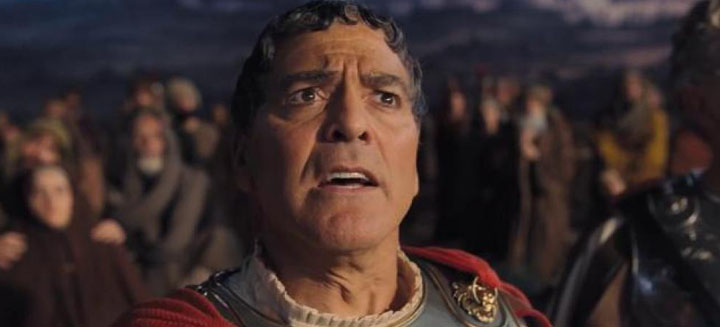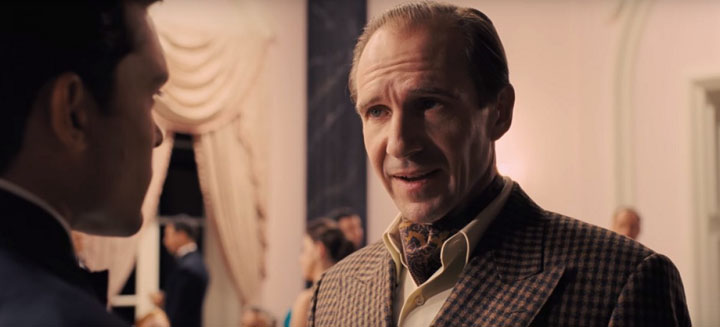Hail, Caesar! (review)
Hail, Caesar! is the new movie by Ethan and Joel Coen, who previously directed Fargo (1996), The Big Lebowski (1998), O Brother, Where Art Thou (2000), No Country for Old Men (2007), and others. Hail, Caesar! takes place in the 1950s and follows the adventures of a Hollywood fixer called Eddie Mannix (played vaguely in the style of a hard-boiled detective by Josh Brolin).
The title of the movie is taken from the film that the studio Eddie Mannix works for is making: a big, Hollywood epic set in ancient times, telling the story of Jesus Christ from the perspective of a Roman officer, played by George Clooney’s character Baird Whitlock. The bits and pieces we see of this production plays entirely to all the tropes that we have become used to: the Romans wear armour that is at best only vaguely historical and seems to be made of plastic, they nearly all have leather or plastic vambraces, they march to the sound of drums, and so forth. And Baird Whitlock naturally wears a leather cuirass! (Ian Ross recently posted an article on the ten things the Romans didn’t have.)
Early in the movie, Whitlock is drugged, kidnapped and held for ransom, and this becomes the overall main plot for the rest of the film. It is not a particularly deep plot and largely an excuse for the directors to follow Eddie Mannix as he deals with one minor crisis after another. Characters are introduced in one scene, given a few funny lines or moments, and are then disposed off in a subsequent scene (if they reappear at all). In this way, Ralp Fiennes, Scarlett Johansson, Jonah Hill, Channing Tatum, Christopher Lambert, and a few others all have one or two brief moments to mug before the camera before the directors move on to the next thing. Their roles are more like glorified cameos.
This makes the movie come across more like a sketch show. The main plot isn’t particularly deep and all of the characters are essentially two-dimensional caricatures. The story’s main protagonist, Eddie Mannix, has a very minor arc. He has an apparently well-paid job at the studio, but was offered an even better paying job somewhere else, and is unsure of what to do. In the meantime, he is also trying to quit smoking, but likewise is having a hard time doing so, occasionally bumming a cigarette anyway and then lying about this to his wife (whom we again see in only one scene). Mannix is thus not a particularly interesting character; his plight is trivial.
 The movie shows random scenes taken from films produced by the fictional Capitol Studios that Mannix works for. Alden Ehrenreich plays Hobie Doyle, a simple southern farm-boy who managed to become the lead in a number of westerns (a big genre in the 1950s and 1960s, after all), performing his own stunts and singing songs. Scarlett Johansson’s character performs in a water ballet movie of the sort that Esther Williams once made famous. Ralp Fiennes plays a foppish director who makes serious dramatic movies. And so on. As an overview of what was going on in Hollywood at the time (including communism), the movie works as a tongue-in-cheek tribute to days gone by.
The movie shows random scenes taken from films produced by the fictional Capitol Studios that Mannix works for. Alden Ehrenreich plays Hobie Doyle, a simple southern farm-boy who managed to become the lead in a number of westerns (a big genre in the 1950s and 1960s, after all), performing his own stunts and singing songs. Scarlett Johansson’s character performs in a water ballet movie of the sort that Esther Williams once made famous. Ralp Fiennes plays a foppish director who makes serious dramatic movies. And so on. As an overview of what was going on in Hollywood at the time (including communism), the movie works as a tongue-in-cheek tribute to days gone by.
It’s just a pity that everything feels so superficial and unfocused, though I do think this is a film that will probably get better with repeat viewings. Based on this movie, you reach the conclusion that actors are dimwitted and spoiled, directors are pretentious, writers are frustrated pseudo-intellectuals obsessed with gaining recognition for their contributions to the movie-making process, and journalists care only about gossip. In that sense, the Coen brothers haven’t really broken any new ground here, playing instead to established stereotype.
There are quirks when it comes to how some of the action is shot. For example, Channing Tatum’s character gets a big song-and-dance scene in a movie-within-the-movie, but it’s shot in a way that confusingly mixes what seems like the actual scene from the fictional movie and our own perspective from the set. There are no cuts; the entire scene is apparently filmed in a single go, using multiple cameras. We get a view of the scene from the top of a short flight of stairs, but when the camera cuts to another position further down, the earlier camera is nowhere to be seen. Did we just see the scene as it is incorporated into the fictional movie? The same applies for Scarlett Johansson’s water ballet scene, but not to Alden Ehrenreich’s attempt to play a scene in a serious drama. It’s a bit confusing, although it’s clear why the directors did what they did: showing multiple scenes being made realistically would have become a chore, and these short vignettes are largely a celebration of particular styles of movies that Hollywood hasn’t touched in a long time or that were otherwise typical of the era (westerns, musicals, water ballet, ancient epics, serious dramas).
 That all sounds like I’m horribly down on the movie, but I did enjoy my time in the cinema and would be interested in seeing it again. It’s just a pity that the characters are so simplistic and the movie feels like a bit of an unfocused, superficial mess. Still, it’s certainly a fun, lighthearthed film to sit through, even though the comedy elicits chuckles rather than hearty belly laughs.
That all sounds like I’m horribly down on the movie, but I did enjoy my time in the cinema and would be interested in seeing it again. It’s just a pity that the characters are so simplistic and the movie feels like a bit of an unfocused, superficial mess. Still, it’s certainly a fun, lighthearthed film to sit through, even though the comedy elicits chuckles rather than hearty belly laughs.

